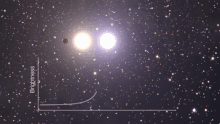| Part of a series of articles about |
| Gravitational lensing |
|---|
 |
|
Einstein ring Formalism Strong lensing Microlensing Weak lensing |
Gravitational microlensing is an astronomical phenomenon caused by the gravitational lens effect. It can be used to detect objects that range from the mass of a planet to the mass of a star, regardless of the light they emit. Typically, astronomers can only detect bright objects that emit much light (stars) or large objects that block background light (clouds of gas and dust). These objects make up only a minor portion of the mass of a galaxy.[clarification needed] Microlensing allows the study of objects that emit little or no light.


When a distant star or quasar gets sufficiently aligned with a massive compact foreground object, the bending of light due to its gravitational field, as discussed by Albert Einstein in 1915, leads to two distorted images (generally unresolved), resulting in an observable magnification. The time-scale of the transient brightening depends on the mass of the foreground object as well as on the relative proper motion between the background 'source' and the foreground 'lens' object.
Ideally aligned microlensing produces a clear buffer between the radiation from the lens and source objects. It magnifies the distant source, revealing it or enhancing its size and/or brightness. It enables the study of the population of faint or dark objects such as brown dwarfs, red dwarfs, planets, white dwarfs, neutron stars, black holes, and massive compact halo objects. Such lensing works at all wavelengths, magnifying and producing a wide range of possible warping for distant source objects that emit any kind of electromagnetic radiation.
Microlensing by an isolated object was first detected in 1989. Since then, microlensing has been used to constrain the nature of the dark matter, detect exoplanets, study limb darkening in distant stars, constrain the binary star population, and constrain the structure of the Milky Way's disk. Microlensing has also been proposed as a means to find dark objects like brown dwarfs and black holes, study starspots, measure stellar rotation, and probe quasars[1][2] including their accretion disks.[3][4][5][6] Microlensing was used in 2018 to detect Icarus, then the most distant star ever observed.[7][8]
- ^ Joachim Wambsganss (2006). "Gravitational Microlensing". Gravitational Lensing: Strong, Weak and Micro. Saas-Fee Advanced Courses. Vol. 33. Saas-Fee Lectures, Springer-Verlag. pp. 453–540. doi:10.1007/978-3-540-30310-7_4. ISBN 978-3-540-30309-1. S2CID 119384147.
- ^ Kochanek, C. S. (2004). "Quantitative Interpretation of Quasar Microlensing Light Curves". The Astrophysical Journal. 605 (1): 58–77. arXiv:astro-ph/0307422. Bibcode:2004ApJ...605...58K. doi:10.1086/382180. S2CID 18391317.
- ^ Poindexter, Shawn; Morgan, Nicholas; Kochanek, Christopher S. (2008). "The Spatial Structure of An Accretion Disk". The Astrophysical Journal. 673 (1): 34–38. arXiv:0707.0003. Bibcode:2008ApJ...673...34P. doi:10.1086/524190. S2CID 7699211.
- ^ Eigenbrod, A.; Courbin, F.; Meylan, G.; Agol, E.; Anguita, T.; Schmidt, R. W.; Wambsganss, J. (2008). "Microlensing variability in the gravitationally lensed quasar QSO 2237+0305 = the Einstein Cross. II. Energy profile of the accretion disk". Astronomy & Astrophysics. 490 (3): 933–943. arXiv:0810.0011. Bibcode:2008A&A...490..933E. doi:10.1051/0004-6361:200810729. S2CID 14230245.
- ^ Mosquera, A. M.; Muñoz, J. A.; Mediavilla, E. (2009). "Detection of chromatic microlensing in Q 2237+0305 A". The Astrophysical Journal. 691 (2): 1292–1299. arXiv:0810.1626. Bibcode:2009ApJ...691.1292M. doi:10.1088/0004-637X/691/2/1292. S2CID 15724872.
- ^ Floyd, David J. E.; Bate, N. F.; Webster, R. L. (2009). "The accretion disc in the quasar SDSS J0924+0219". Monthly Notices of the Royal Astronomical Society. 398 (1): 233–239. arXiv:0905.2651. Bibcode:2009MNRAS.398..233F. doi:10.1111/j.1365-2966.2009.15045.x. S2CID 18381541.
- ^ Kelly (2018). "Extreme magnification of an individual star at redshift 1.5 by a galaxy-cluster lens". Nature Astronomy. 2 (4): 334–342. arXiv:1706.10279. Bibcode:2018NatAs...2..334K. doi:10.1038/s41550-018-0430-3. S2CID 125826925.
- ^ Diego (2018). "Dark Matter under the Microscope: Constraining Compact Dark Matter with Caustic Crossing Events". The Astrophysical Journal. 857 (1): 25–52. arXiv:1706.10281. Bibcode:2018ApJ...857...25D. doi:10.3847/1538-4357/aab617. S2CID 55811307.